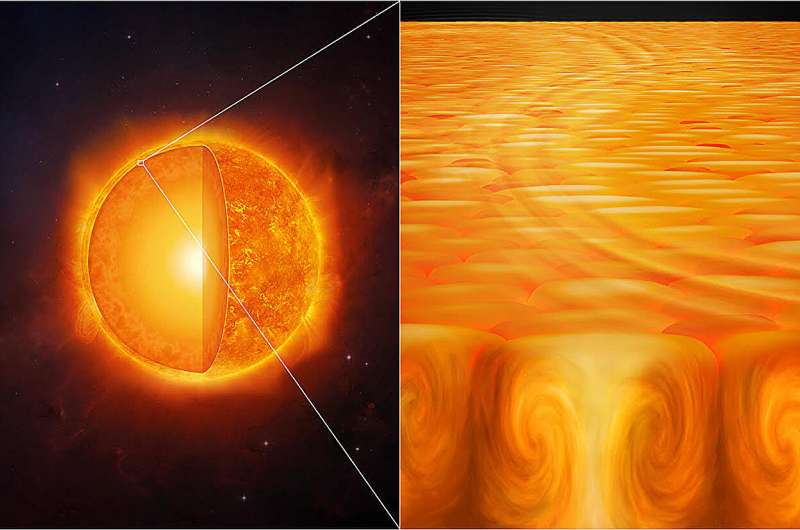This article has been reviewed according to Science X's editorial process and policies. Editors have highlighted the following attributes while ensuring the content's credibility:
fact-checked
peer-reviewed publication
trusted source
proofread
Using sound waves, scientists develop findings that challenge standard theories of solar convection

A team of solar physicists at NYU Abu Dhabi's Center for Astrophysics and Space Science (CASS), led by Research Scientist Chris S. Hanson, Ph.D., has revealed the interior structure of the sun's supergranules, a flow structure that transports heat from the sun's hidden interior to its surface. The researchers' analysis of the supergranules presents a challenge to the current understanding of solar convection.
The sun generates energy in its core through nuclear fusion; that energy is then transported to the surface, where it escapes as sunlight. In a study titled "Supergranular-scale solar convection not explained by mixing-length theory," published in the journal Nature Astronomy, the researchers explain how they utilized Doppler, intensity and magnetic images from the helioseismic and magnetic imager (HMI) onboard NASA's Solar Dynamics Observatory (SDO) satellite to identify and characterize approximately 23,000 supergranules.
Since the sun's surface is opaque to light, the NYUAD scientists used sound waves to probe the interior structure of the supergranules. These sound waves, which are generated by the smaller granules and are everywhere in the sun, have been successfully used in the past in a field known as helioseismology.
By analyzing such a large dataset of supergranules, which were estimated to extend 20,000 km (~3% into the interior) below the surface of the sun, the scientists were able to determine the up- and downflows associated with supergranular heat transport with unprecedented accuracy. In addition to inferring how deep the supergranules extend, the scientists also discovered that the downflows appeared approximately 40% weaker than the upflows, which suggests that some component was missing from the downflows.
Through extensive testing and theoretical arguments, the authors theorize that the "missing" or unseen component could consist of small scale (approximately 100 km) plumes that transport cooler plasma down into the sun's interior. The sound waves in the sun would be too big to sense these plumes, making the downflows appear weaker. These findings cannot be explained by the widely used mixing-length description of solar convection.
"Supergranules are a significant component of the heat transport mechanisms of the sun, but they present a serious challenge for scientists to understand," said Shravan Hanasoge, Ph.D., research professor, co-author of the paper and co-Principal Investigator of CASS. "Our findings counter assumptions that are central to the current understanding of solar convection, and should inspire further investigation of the sun's supergranules."
The research was conducted within CASS at NYUAD in collaboration with Tata Institute of Fundamental Research, Princeton University, and New York University, using NYUAD's high performance computing resources.
More information: Supergranular-scale solar convection not explained by mixing-length theory, Nature Astronomy (2024). www.nature.com/articles/s41550-024-02304-w
Journal information: Nature Astronomy
Provided by New York University




















